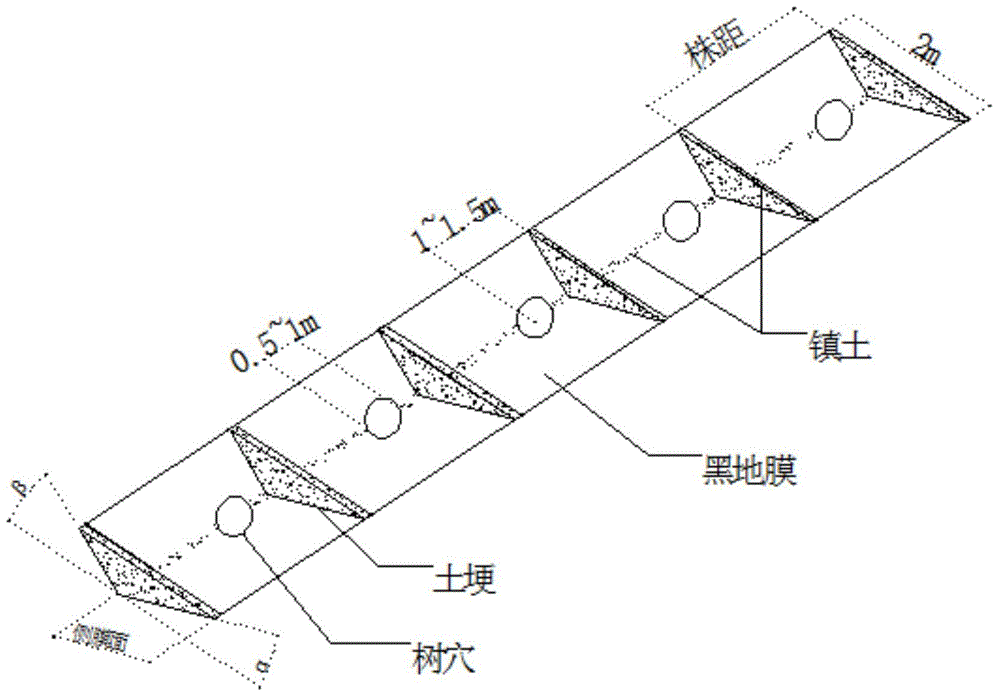Arid and semi-arid region forest rainwater collecting and drought resisting cultivation method
A drought-resistant cultivation and semi-drought technology, applied in the field of forestry engineering, can solve problems such as numerous operation steps, uneven distribution of rainwater, small water collection surface, etc., and achieve the effects of high flow collection efficiency, shortening the period of nursery out, and small earthwork volume
- Summary
- Abstract
- Description
- Claims
- Application Information
AI Technical Summary
Problems solved by technology
Method used
Image
Examples
Embodiment 1
[0018] On the flat land where the soil quality is sandy and the distance between plants and rows is 4m×5m, the rain-collecting ditch is horizontally excavated along the tree line and along the contour line, and the ditch width is 2m. The two sides of the ditch are flattened in a "V" shape, and the slopes of both sides of the ditch are 10°. The ditch is divided into bamboo-shaped segmental ditches with soil according to the length of the plant spacing. At 1m, excavate a circular planting hole with a diameter of 0.5m and a depth of 10cm, and plant a walnut grafted seedling in each hole; use a black and white double-sided mulch film with a thickness of 0.008mm and a width of 1.2m, and the double-film butt joint longitudinally covers the bamboo joints In the “V”-shaped rain-collecting ditch area, the joints are tightly compacted with soil, and the plastic film is suppressed with soil on the horizontal bamboo-shaped separation ridge, and a small seepage hole with a diameter of 1cm i...
Embodiment 2
[0020] On the 3-year-old juvenile apple grafted seedling cultivation ground with loamy soil, plot slope of 25°, and row spacing of 4m×4m, horizontally excavate the rainwater collection ditch along the tree row and along the contour line, the ditch width is 2m, and the tree planting row On the center line of the ditch, level the two sides of the ditch to form a "V" shape. The slope of the upper side of the ditch is 25°, and the slope of the lower side is 10°. For the section ditch, excavate a circular planting hole with a diameter of 0.8m and a depth of 10cm at the 1.5m place where the distance between each section of the ditch area is closer, and plant a grafted apple seedling in each hole; 1.2m black and white striped film, the double-film butt joint longitudinally covers the bamboo-shaped "V"-shaped rain-collecting ditch area, the butt joint is tightly suppressed with soil, and the horizontal bamboo-shaped separation ridge is used to suppress the film with soil, and the film ...
Embodiment 3
[0022] On the 2-year-old walnut grafted seedling cultivation land with loamy soil, slope of 30°, and annual precipitation of 435mm, the distance between plants and rows is 4m×5m. The planting line is on the center line of the ditch, and the two sides of the ditch are leveled to form a "V" shape. The slope of the upper side of the ditch is 30°, and the slope of the lower side is 10°. According to the length of the distance between plants, the ditch is separated into bamboo joints with soil. In the section-shaped ditch, excavate a circular planting hole with a diameter of 1m and a depth of 10cm at the distance of 1.2m from the closer separation ridge in each section of the ditch, and plant a walnut grafted seedling in the hole; 1.5m black mulch, the double-membrane butt joint longitudinally covers the bamboo-shaped "V"-shaped ditch area, the joint is suppressed with soil, and the two sides of the horizontal bamboo-shaped separation ridge are suppressed with soil, and 3 circles ar...
PUM
 Login to View More
Login to View More Abstract
Description
Claims
Application Information
 Login to View More
Login to View More - R&D
- Intellectual Property
- Life Sciences
- Materials
- Tech Scout
- Unparalleled Data Quality
- Higher Quality Content
- 60% Fewer Hallucinations
Browse by: Latest US Patents, China's latest patents, Technical Efficacy Thesaurus, Application Domain, Technology Topic, Popular Technical Reports.
© 2025 PatSnap. All rights reserved.Legal|Privacy policy|Modern Slavery Act Transparency Statement|Sitemap|About US| Contact US: help@patsnap.com

